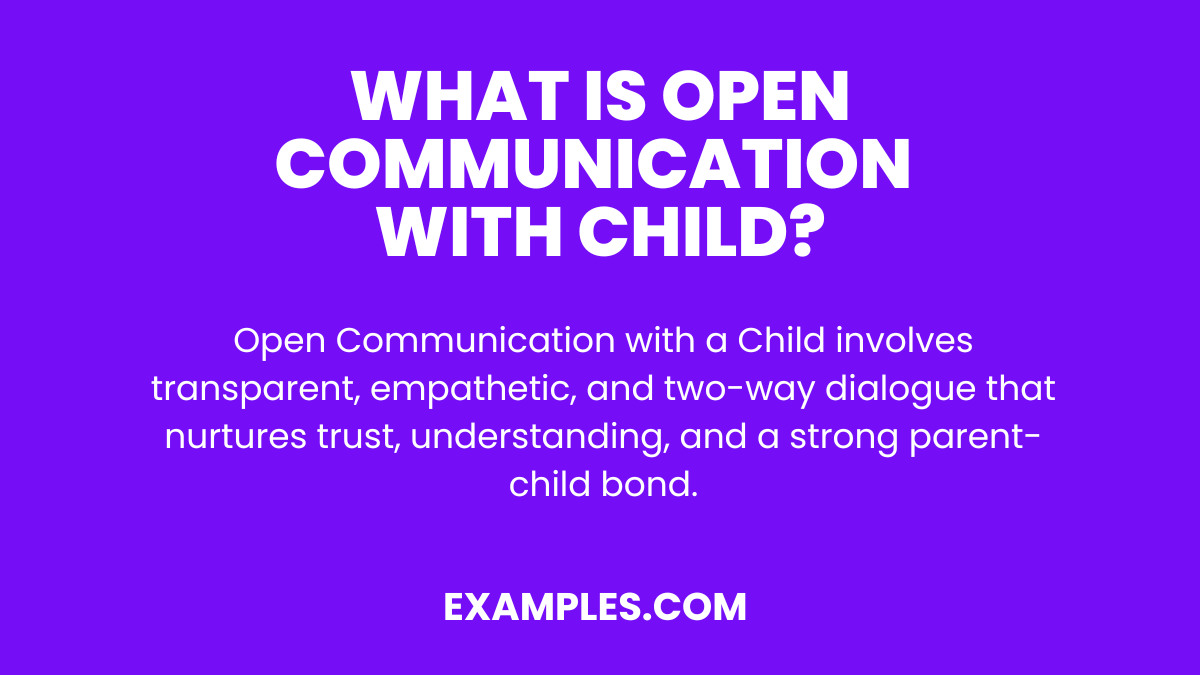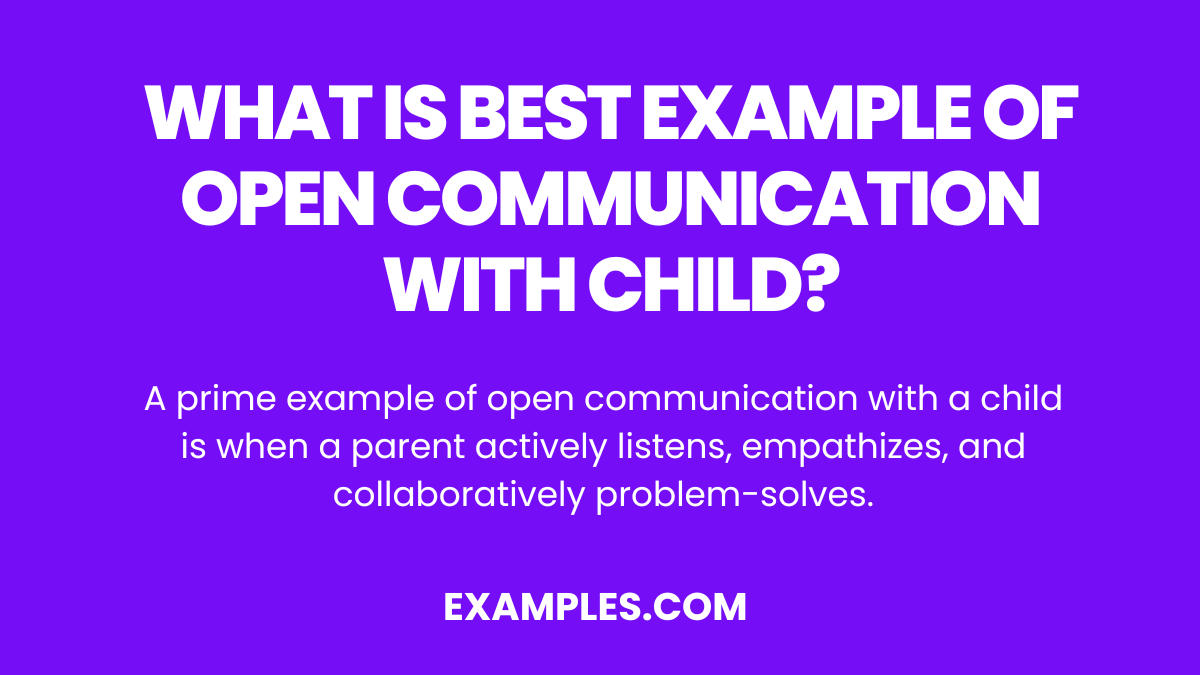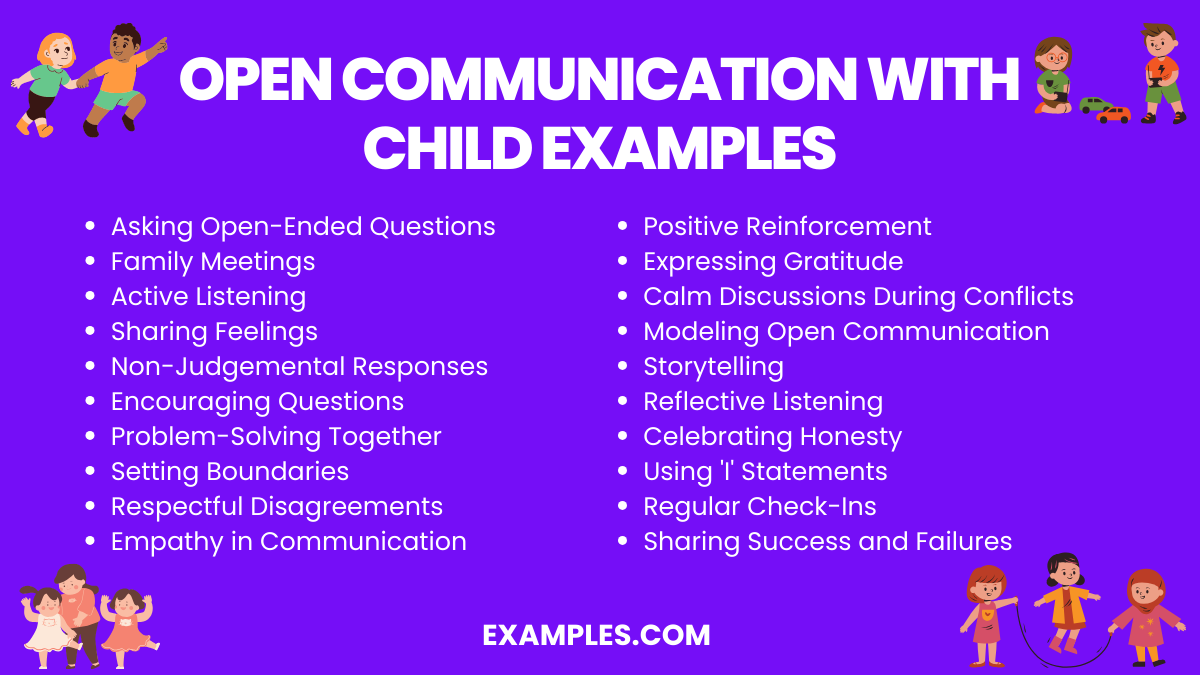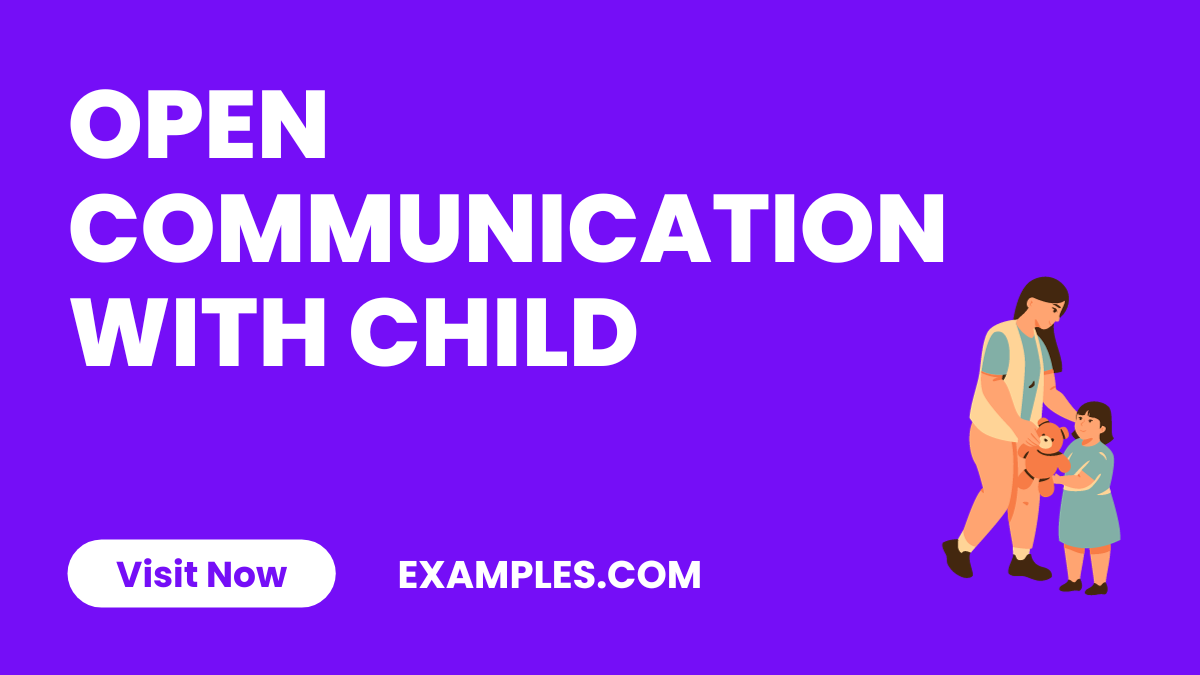20+ Open Communication with Child Examples
Dive into the realm of effective parenting with our comprehensive guide on Open Communication with a Child. Uncover a treasure trove of practical Communication Examples, strategies, and insights to foster a nurturing and honest relationship with your little ones. From setting the right tone to overcoming challenges, this guide is your go-to resource for enhancing dialogue and understanding in your family.
Download Effective Open Communication with Child PDF
What is Open Communication with a Child? – Meaning

Open communication with a child means engaging in an honest, transparent, and two-way dialogue that encourages children to express their thoughts and feelings without fear. This approach promotes trust, understanding, and a strong bond between parents and children, emphasizing listening, empathy, and respect as key components. It’s about creating a safe environment where every family member feels valued and heard.
What is the Best Example of Open Communication with a Child?

The best example of Open Communication with a child might involve a scenario where a parent calmly and attentively listens to their child’s account of a challenging situation at school. Instead of immediately offering solutions or dismissing the child’s concerns, the parent acknowledges the child’s feelings, asks open-ended questions to understand better, and together, they explore potential solutions. This approach not only solves the immediate issue but also teaches the child valuable problem-solving skills and builds a deeper trust and connection between parent and child.
20 Open Communication with Child Examples

Discover the art of effective parent-child dialogue with our insightful guide on Open Communication with Child Examples. This collection not only offers 20 unique and practical examples of open communication but also delves into the causes and solutions for each scenario. Enhance your parenting skills by understanding the Importance of Open Communication and learn how to foster an environment of Honest Communication, akin to practices in Open Communication in Healthcare and Open Communication in the Workplace.
- Asking Open-Ended Questions: Encourages children to express more than just ‘yes’ or ‘no’.
Cause: Limited conversation starters. Fix: Use prompts like, “What was the best part of your day?” - Family Meetings: Regularly discussing family matters.
Cause: Lack of family involvement. Fix: Establish a weekly family meeting tradition. - Active Listening: Showing genuine interest in the child’s words.
Cause: Dismissive parental responses. Fix: Practice full attention listening. - Sharing Feelings: Parents openly expressing their emotions.
Cause: Emotional disconnect. Fix: Regularly share feelings and encourage kids to do the same. - Non-Judgemental Responses: Accepting the child’s viewpoint.
Cause: Fear of criticism. Fix: Respond with understanding, not judgement. - Encouraging Questions: Letting kids ask about anything.
Cause: Curiosity suppression. Fix: Answer their questions honestly and patiently. - Problem-Solving Together: Involving children in decision-making.
Cause: Overprotection. Fix: Collaborate on solutions to problems. - Setting Boundaries: Clear communication of rules and expectations.
Cause: Unclear limits. Fix: Discuss and set boundaries together. - Respectful Disagreements: Teaching constructive conflict resolution.
Cause: Avoidance of conflict. Fix: Model respectful disagreement. - Empathy in Communication: Showing understanding of their feelings.
Cause: Emotional invalidation. Fix: Express empathy during conversations. - Positive Reinforcement: Praising good communication.
Cause: Lack of motivation. Fix: Offer positive feedback for open discussions. - Expressing Gratitude: Showing appreciation for honest talks.
Cause: Taking communication for granted. Fix: Regularly express gratitude. - Calm Discussions During Conflicts: Keeping a cool head. Cause: Heated arguments. Fix: Practice calmness during disagreements.
- Modeling Open Communication: Parents exemplifying open dialogue.
Cause: Lack of examples. Fix: Be a role model in communication. - Storytelling: Sharing stories that teach lessons.
Cause: Lack of engagement. Fix: Use storytelling to convey messages. - Reflective Listening: Echoing what the child says.
Cause: Misunderstandings. Fix: Repeat back to confirm understanding. - Celebrating Honesty: Rewarding truthful communication.
Cause: Fear of punishment. Fix: Show appreciation for honesty. - Using ‘I’ Statements: Avoiding blame.
Cause: Accusatory language. Fix: Communicate feelings without blaming. - Regular Check-Ins: Asking about their day.
Cause: Feeling of neglect. Fix: Initiate daily check-ins. - Sharing Success and Failures: Discussing both highs and lows.
Cause: One-sided communication. Fix: Share personal experiences openly.
Open Communication with Child in School
Unlock the potential of your child’s educational experience with Open Communication with Child in School. Engaging in meaningful dialogue about academic life can dramatically enhance learning and emotional well-being. Embrace strategies that promote Open Mind Communication, understand the role of Open Communication in Family in academic success, and learn how Open Communication in Leadership within schools can create a thriving educational environment. Discover how to cultivate a supportive atmosphere that encourages children to excel and communicate effectively in their academic journey.
- Parent-Teacher Conferences: Regular meetings between parents and teachers to discuss the child’s progress. How to Communicate: “I’ve noticed [Child’s Name] struggles with [subject]. How can we work together to support them?”
- Student-Led Discussions: Encouraging students to express their academic needs and thoughts. How to Communicate: “Tell me what you enjoy about [subject] and where you find challenges.”
- Feedback Loops: Constructive feedback on academic and personal development. How to Communicate: “I’m proud of how you handled [situation]. What do you think you learned from it?”
- Curriculum Input Meetings: Allowing parents and students to have a say in learning topics. How to Communicate: “What topics are you interested in learning more about this year?”
- School Policy Discussions: Involving children in understanding and even shaping school policies. How to Communicate: “How do you feel about the new policy at school? Let’s discuss what it means for you.”
How Can Parents Promote Open Communication with Their Child?
Promoting Open Communication with Child is pivotal for nurturing trust and understanding. Parents play a crucial role in modeling and encouraging an environment where children feel safe to express their thoughts and feelings.
- Be an Active Listener: Show genuine interest in what your child says. Open Communication with Parents starts with paying full attention, acknowledging their feelings, and responding appropriately.
- Create a Sharing Routine: Establish regular family time where everyone shares their day’s experiences. This ritual becomes a cornerstone of Open Communication with Child.
- Encourage Expression of Feelings: Teach your child that all emotions are valid and provide them with the vocabulary to express themselves effectively.
- Practice Empathy: Put yourself in your child’s shoes and respond with empathy and understanding. This empathy is what fosters Open Communication with Students as well.
- Set a Positive Example: Model the communication behavior you want to see in your child. Your actions in Open Communication with Colleagues and others will serve as a guide for them.
Why is it Important to Establish Open Communication with Child?
Establishing Open Communication with Child is vital for their emotional and psychological development. It forms the bedrock of a healthy, trusting Open Communication in Relationship between parents and children.
- Builds Trust: Open dialogue creates a trustworthy environment where children feel secure in sharing their thoughts and feelings.
- Enhances Problem-Solving Skills: Children learn to think critically and express their problems and ideas clearly.
- Promotes Emotional Health: Regular, open communication helps children process their emotions and reduces stress and anxiety.
- Strengthens Relationship: It deepens the parent-child bond and fosters mutual respect and understanding.
- Prepares for Future Interactions: Children learn how to communicate effectively with others, benefitting their future interactions with peers, educators, and eventually, Open Communication with Manager in their professional lives.
What Strategies Can Parents Use to Encourage Open Communication with Their Child?
Encouraging open communication requires intentional strategies that promote dialogue and understanding. Here are steps to create an environment of open and honest communication.
- Establish a Safe Space: Make your home a safe space where children can share without fear of judgment or punishment. This safety is akin to the comfort patients should feel in Open Communication with Patients.
- Use Appropriate Language: Adapt your language and content to be age-appropriate, ensuring the child understands and feels understood.
- Acknowledge and Validate: Recognize your child’s feelings and perspectives as valid, encouraging them to continue sharing.
- Teach by Example: Demonstrate effective communication in your interactions with others, especially in Open Communication with Colleagues and family members.
- Stay Consistent and Patient: Regularly engage in open dialogue and be patient as your child learns to articulate their thoughts and feelings. This consistent effort mirrors the dedication needed in professional settings, like Open Communication with Manager.
Why Is It Important to Keep the Lines of Communication Open with Your Children?
Keeping lines open ensures children feel heard and valued, vital for emotional development and family unity, resembling Open Communication with Stakeholders in transparency.
How Does Active Listening Contribute to Open Communication with a Child?
Active listening validates children’s feelings, encourages further sharing, and builds a robust dialogue, akin to the Open Communication Benefits seen in Open Communication vs Closed Communication.
What Role Does Trust Play in Maintaining Open Communication with Your Child?
Trust is the foundation of open communication, ensuring a safe space for honest dialogue, similar to the trust necessary in Open Communication vs Direct Communication.
In conclusion, open communication with your child paves the way for a healthy, trusting relationship filled with mutual understanding and respect. By embracing strategies like active listening, empathy, and honest dialogue, parents can effectively address issues, celebrate successes, and foster an environment where children feel empowered and supported to express themselves fully. It’s a transformative journey with lasting positive effects on your child’s development.
20+ Open Communication with Child Examples

Dive into the realm of effective parenting with our comprehensive guide on Open Communication with a Child. Uncover a treasure trove of practical Communication Examples, strategies, and insights to foster a nurturing and honest relationship with your little ones. From setting the right tone to overcoming challenges, this guide is your go-to resource for enhancing dialogue and understanding in your family.
Download Effective Open Communication with Child PDF
What is Open Communication with a Child? – Meaning

Open communication with a child means engaging in an honest, transparent, and two-way dialogue that encourages children to express their thoughts and feelings without fear. This approach promotes trust, understanding, and a strong bond between parents and children, emphasizing listening, empathy, and respect as key components. It’s about creating a safe environment where every family member feels valued and heard.
What is the Best Example of Open Communication with a Child?

The best example of Open Communication with a child might involve a scenario where a parent calmly and attentively listens to their child’s account of a challenging situation at school. Instead of immediately offering solutions or dismissing the child’s concerns, the parent acknowledges the child’s feelings, asks open-ended questions to understand better, and together, they explore potential solutions. This approach not only solves the immediate issue but also teaches the child valuable problem-solving skills and builds a deeper trust and connection between parent and child.
20 Open Communication with Child Examples

Discover the art of effective parent-child dialogue with our insightful guide on Open Communication with Child Examples. This collection not only offers 20 unique and practical examples of open communication but also delves into the causes and solutions for each scenario. Enhance your parenting skills by understanding the Importance of Open Communication and learn how to foster an environment of Honest Communication, akin to practices in Open Communication in Healthcare and Open Communication in the Workplace.
Asking Open-Ended Questions: Encourages children to express more than just ‘yes’ or ‘no’.
Cause: Limited conversation starters. Fix: Use prompts like, “What was the best part of your day?”Family Meetings: Regularly discussing family matters.
Cause: Lack of family involvement. Fix: Establish a weekly family meeting tradition.Active Listening: Showing genuine interest in the child’s words.
Cause: Dismissive parental responses. Fix: Practice full attention listening.Sharing Feelings: Parents openly expressing their emotions.
Cause: Emotional disconnect. Fix: Regularly share feelings and encourage kids to do the same.Non-Judgemental Responses: Accepting the child’s viewpoint.
Cause: Fear of criticism. Fix: Respond with understanding, not judgement.Encouraging Questions: Letting kids ask about anything.
Cause: Curiosity suppression. Fix: Answer their questions honestly and patiently.Problem-Solving Together: Involving children in decision-making.
Cause: Overprotection. Fix: Collaborate on solutions to problems.Setting Boundaries: Clear communication of rules and expectations.
Cause: Unclear limits. Fix: Discuss and set boundaries together.Respectful Disagreements: Teaching constructive conflict resolution.
Cause: Avoidance of conflict. Fix: Model respectful disagreement.Empathy in Communication: Showing understanding of their feelings.
Cause: Emotional invalidation. Fix: Express empathy during conversations.Positive Reinforcement: Praising good communication.
Cause: Lack of motivation. Fix: Offer positive feedback for open discussions.Expressing Gratitude: Showing appreciation for honest talks.
Cause: Taking communication for granted. Fix: Regularly express gratitude.Calm Discussions During Conflicts: Keeping a cool head. Cause: Heated arguments. Fix: Practice calmness during disagreements.
Modeling Open Communication: Parents exemplifying open dialogue.
Cause: Lack of examples. Fix: Be a role model in communication.Storytelling: Sharing stories that teach lessons.
Cause: Lack of engagement. Fix: Use storytelling to convey messages.Reflective Listening: Echoing what the child says.
Cause: Misunderstandings. Fix: Repeat back to confirm understanding.Celebrating Honesty: Rewarding truthful communication.
Cause: Fear of punishment. Fix: Show appreciation for honesty.Using ‘I’ Statements: Avoiding blame.
Cause: Accusatory language. Fix: Communicate feelings without blaming.Regular Check-Ins: Asking about their day.
Cause: Feeling of neglect. Fix: Initiate daily check-ins.Sharing Success and Failures: Discussing both highs and lows.
Cause: One-sided communication. Fix: Share personal experiences openly.
Open Communication with Child in School
Unlock the potential of your child’s educational experience with Open Communication with Child in School. Engaging in meaningful dialogue about academic life can dramatically enhance learning and emotional well-being. Embrace strategies that promote Open Mind Communication, understand the role of Open Communication in Family in academic success, and learn how Open Communication in Leadership within schools can create a thriving educational environment. Discover how to cultivate a supportive atmosphere that encourages children to excel and communicate effectively in their academic journey.
Parent-Teacher Conferences: Regular meetings between parents and teachers to discuss the child’s progress. How to Communicate: “I’ve noticed [Child’s Name] struggles with [subject]. How can we work together to support them?”
Student-Led Discussions: Encouraging students to express their academic needs and thoughts. How to Communicate: “Tell me what you enjoy about [subject] and where you find challenges.”
Feedback Loops: Constructive feedback on academic and personal development. How to Communicate: “I’m proud of how you handled [situation]. What do you think you learned from it?”
Curriculum Input Meetings: Allowing parents and students to have a say in learning topics. How to Communicate: “What topics are you interested in learning more about this year?”
School Policy Discussions: Involving children in understanding and even shaping school policies. How to Communicate: “How do you feel about the new policy at school? Let’s discuss what it means for you.”
How Can Parents Promote Open Communication with Their Child?
Promoting Open Communication with Child is pivotal for nurturing trust and understanding. Parents play a crucial role in modeling and encouraging an environment where children feel safe to express their thoughts and feelings.
Be an Active Listener: Show genuine interest in what your child says. Open Communication with Parents starts with paying full attention, acknowledging their feelings, and responding appropriately.
Create a Sharing Routine: Establish regular family time where everyone shares their day’s experiences. This ritual becomes a cornerstone of Open Communication with Child.
Encourage Expression of Feelings: Teach your child that all emotions are valid and provide them with the vocabulary to express themselves effectively.
Practice Empathy: Put yourself in your child’s shoes and respond with empathy and understanding. This empathy is what fosters Open Communication with Students as well.
Set a Positive Example: Model the communication behavior you want to see in your child. Your actions in Open Communication with Colleagues and others will serve as a guide for them.
Why is it Important to Establish Open Communication with Child?
Establishing Open Communication with Child is vital for their emotional and psychological development. It forms the bedrock of a healthy, trusting Open Communication in Relationship between parents and children.
Builds Trust: Open dialogue creates a trustworthy environment where children feel secure in sharing their thoughts and feelings.
Enhances Problem-Solving Skills: Children learn to think critically and express their problems and ideas clearly.
Promotes Emotional Health: Regular, open communication helps children process their emotions and reduces stress and anxiety.
Strengthens Relationship: It deepens the parent-child bond and fosters mutual respect and understanding.
Prepares for Future Interactions: Children learn how to communicate effectively with others, benefitting their future interactions with peers, educators, and eventually, Open Communication with Manager in their professional lives.
What Strategies Can Parents Use to Encourage Open Communication with Their Child?
Encouraging open communication requires intentional strategies that promote dialogue and understanding. Here are steps to create an environment of open and honest communication.
Establish a Safe Space: Make your home a safe space where children can share without fear of judgment or punishment. This safety is akin to the comfort patients should feel in Open Communication with Patients.
Use Appropriate Language: Adapt your language and content to be age-appropriate, ensuring the child understands and feels understood.
Acknowledge and Validate: Recognize your child’s feelings and perspectives as valid, encouraging them to continue sharing.
Teach by Example: Demonstrate effective communication in your interactions with others, especially in Open Communication with Colleagues and family members.
Stay Consistent and Patient: Regularly engage in open dialogue and be patient as your child learns to articulate their thoughts and feelings. This consistent effort mirrors the dedication needed in professional settings, like Open Communication with Manager.
Why Is It Important to Keep the Lines of Communication Open with Your Children?
Keeping lines open ensures children feel heard and valued, vital for emotional development and family unity, resembling Open Communication with Stakeholders in transparency.
How Does Active Listening Contribute to Open Communication with a Child?
Active listening validates children’s feelings, encourages further sharing, and builds a robust dialogue, akin to the Open Communication Benefits seen in Open Communication vs Closed Communication.
What Role Does Trust Play in Maintaining Open Communication with Your Child?
Trust is the foundation of open communication, ensuring a safe space for honest dialogue, similar to the trust necessary in Open Communication vs Direct Communication.
In conclusion, open communication with your child paves the way for a healthy, trusting relationship filled with mutual understanding and respect. By embracing strategies like active listening, empathy, and honest dialogue, parents can effectively address issues, celebrate successes, and foster an environment where children feel empowered and supported to express themselves fully. It’s a transformative journey with lasting positive effects on your child’s development.


